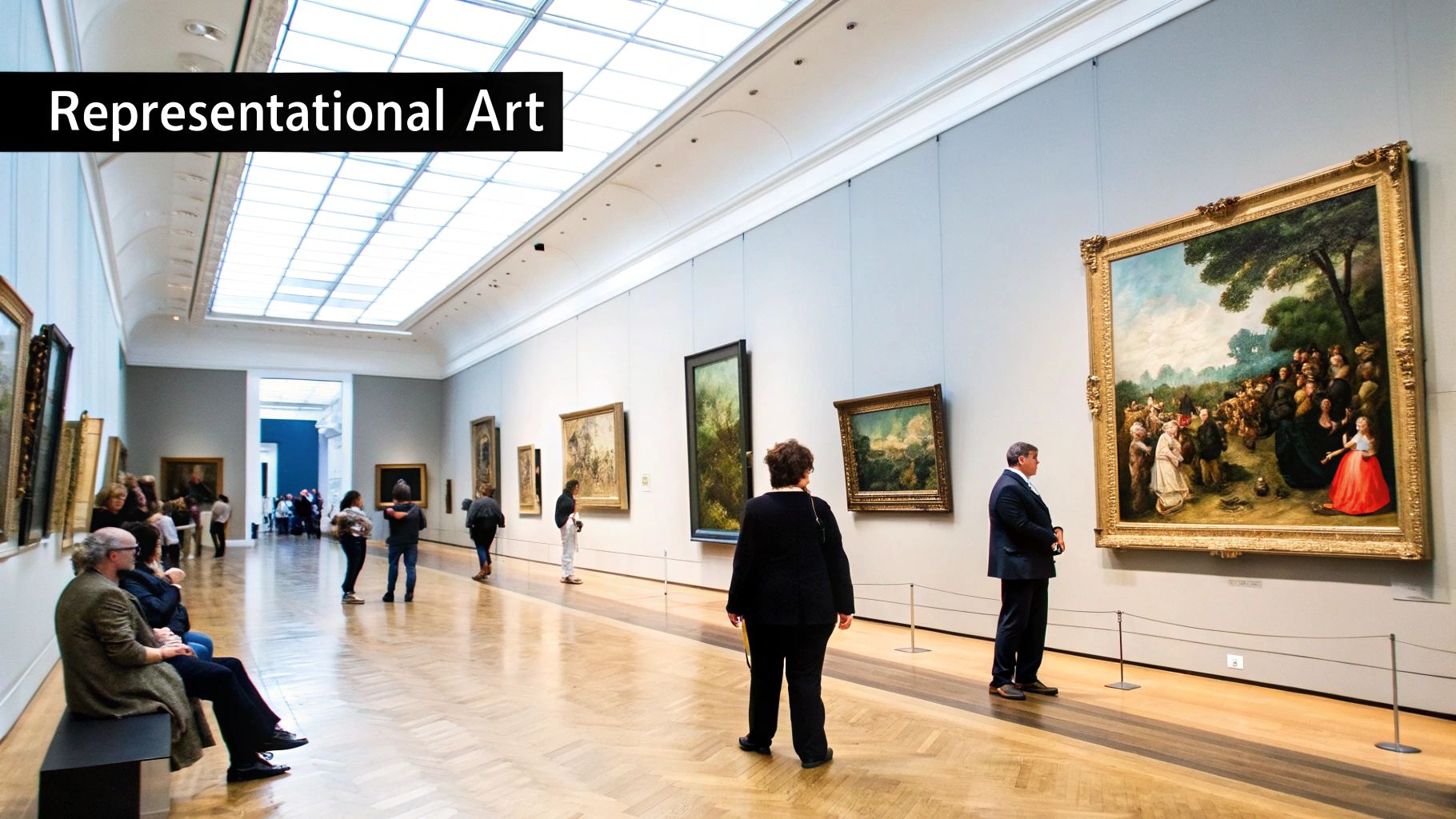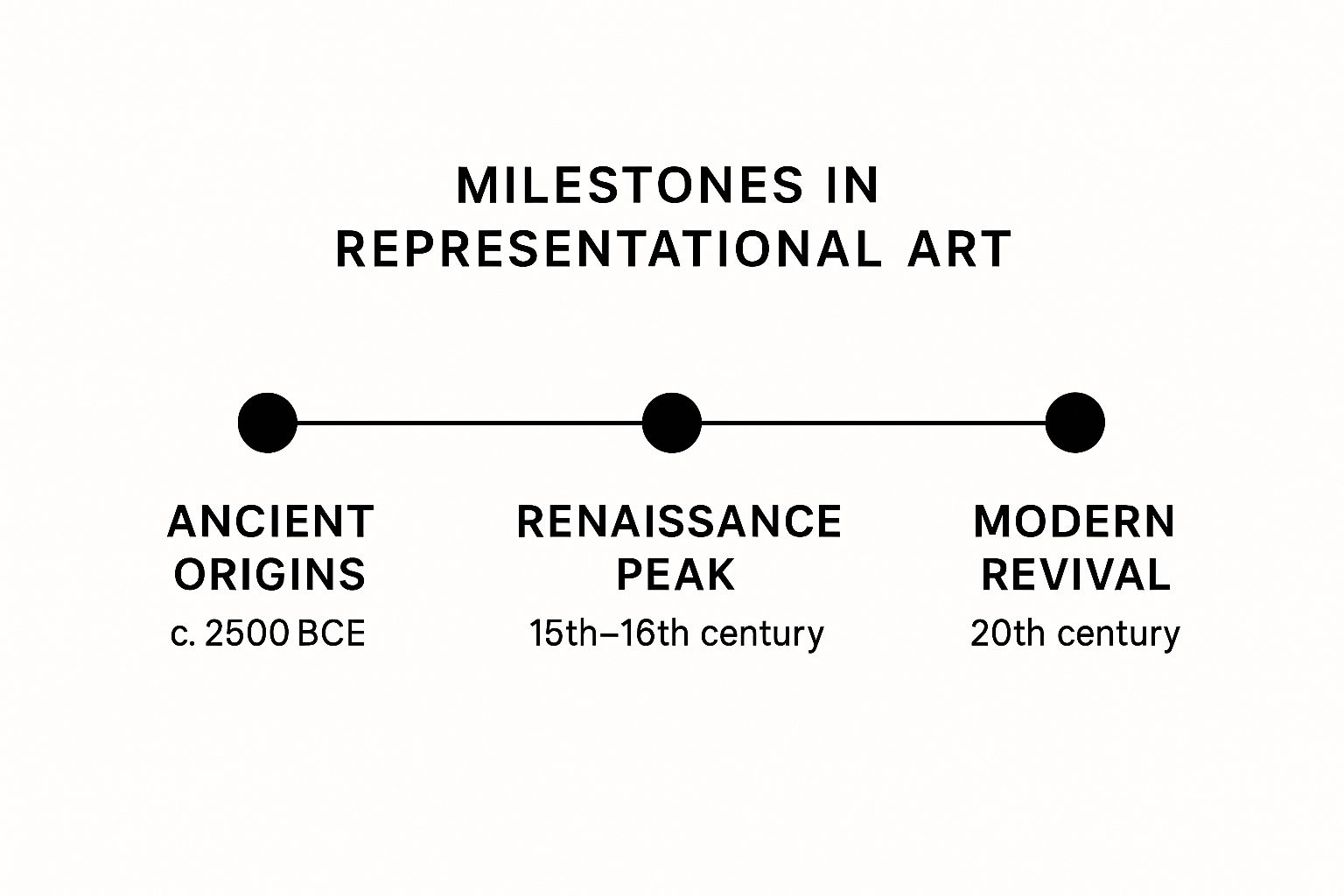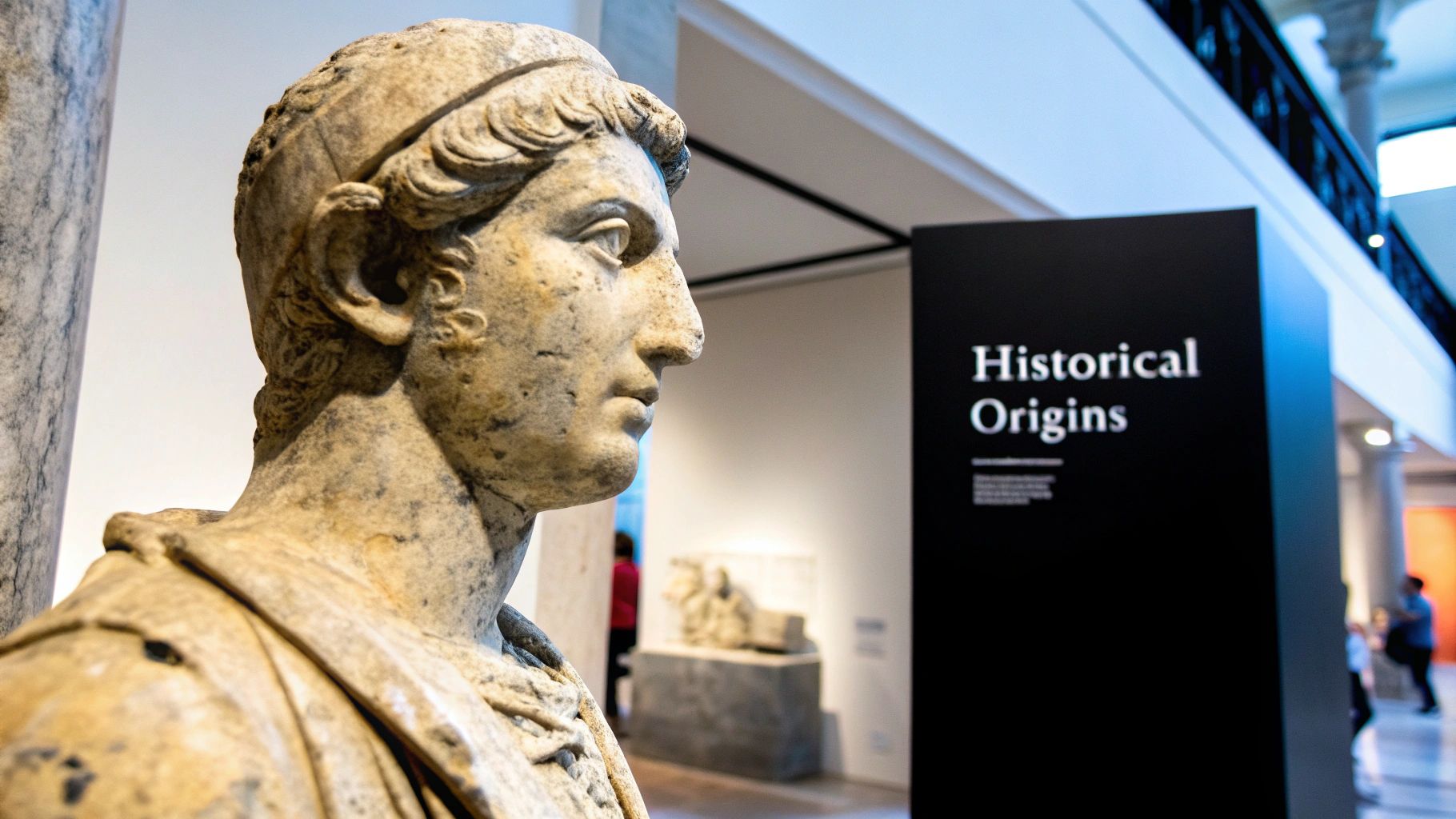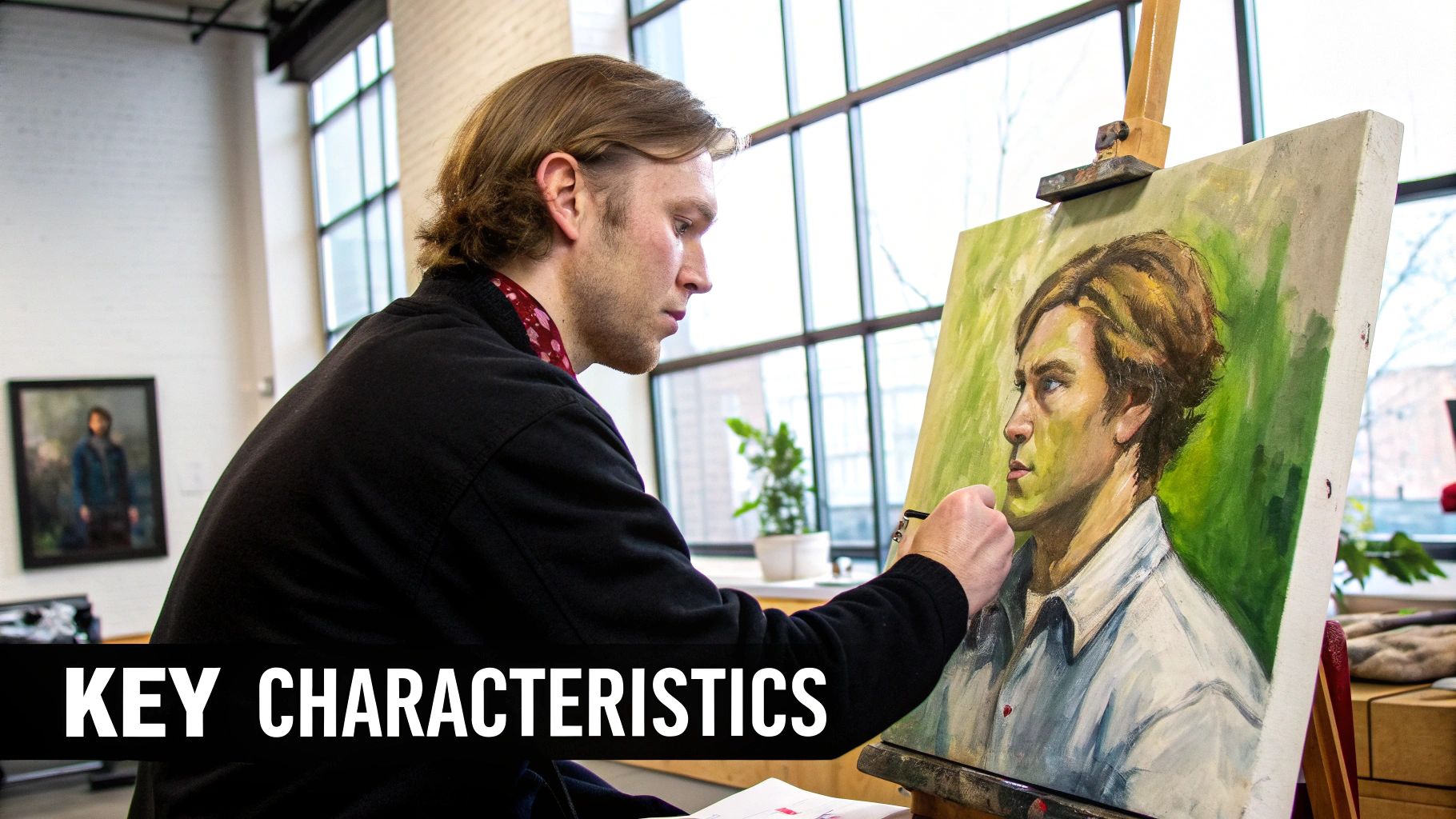If you've ever looked at a painting and immediately recognized a person, a place, or even just a simple bowl of fruit, you've experienced representational art. It's a style that sets out to mirror the real world, depicting subjects in a way that we can all identify.
Think of it as a creative bridge connecting the artist's personal vision to our shared reality. This very quality makes it one of the most relatable and timeless forms of art out there.
What Exactly Is Representational Art?

At its heart, representational art is all about capturing something tangible from the world around us. Unlike abstract art, which might focus purely on color, form, or emotion, the main goal here is recognizability. The artist becomes both an observer and an interpreter, translating what they see onto a canvas or into a sculpture.
Now, this doesn't mean it has to be a perfect, photorealistic copy of reality—that's a common misunderstanding. Representational art actually covers a huge spectrum of styles and interpretations.
The Spectrum of Realism
One artist might paint a portrait with stunningly realistic detail, capturing every single pore and stray hair. Another could paint that same person with looser, more energetic brushstrokes, where the likeness is still clear but not slavishly detailed. Both of these approaches are considered representational because the subject is still identifiable.
This core idea includes a whole host of famous artistic styles:
- Realism: A movement focused on depicting subjects truthfully, without adding artificial or fantastical elements.
- Impressionism: Famous for capturing the sensory feeling of a moment, often prioritizing light and movement over crisp details.
- Figurative Art: A broad term for any art that clearly retains strong references to the real world, particularly the human form.
To make this crystal clear, here’s a simple breakdown of the core concepts.
Representational Art at a Glance
| Core Principle | What It Means | Simple Example |
|---|---|---|
| Recognizable Subjects | The artwork clearly depicts objects, people, or scenes from the real world. | A painting of an apple that looks like an apple. |
| Spectrum of Accuracy | It can range from hyper-realistic to stylized, as long as the subject is identifiable. | A caricature of a celebrity still looks like that person. |
| Connection to Reality | The art is grounded in what we can see and experience. | A sculpture of a horse, even if made of bronze. |
Ultimately, the goal is to create something that resonates with the viewer's own experiences of the world.
The real magic of representational art is that it speaks a universal language. It taps into our natural ability to recognize faces, places, and patterns, telling stories that connect with us across centuries and cultures without needing a complex explanation.
A Journey Through the History of Representational Art
The story of representational art is, in many ways, the story of us. From our earliest moments, the drive to capture the world as we see it has been a fundamental human impulse. It’s a visual diary of our beliefs, our discoveries, and our daily lives, and it all began long before the first museum ever opened its doors.
Think about it: the very first artists were our ancient ancestors, painting powerful images of bison and deer on dark cave walls. Their goal was straightforward and deeply human—to recreate the animals that were so critical to their survival. This simple act of observation and depiction kicked off an artistic tradition that has lasted for millennia.
From Ancient Symbols to Renaissance Realism
This thread of depicting the real world weaves through all the great ancient civilizations. You can see it in the symbolic figures inside Egyptian tombs and in the flawless, idealized human forms carved by the ancient Greeks. Art was their way of telling stories, honoring their gods, and recording history in a language everyone could see and understand.
Fast forward to the Middle Ages, and art often took a more symbolic turn, focusing heavily on religious stories rather than picture-perfect realism. Still, the core idea was representational. The saints and scenes were always meant to be recognized, ensuring the stories resonated with the faithful.
Then came the Renaissance, a true game-changer spanning the 14th to the 17th century. This era saw a seismic shift. Artists like Leonardo da Vinci and Michelangelo became obsessed with achieving a new, breathtaking level of realism. They studied anatomy and developed groundbreaking techniques like linear perspective to craft scenes so lifelike you feel you could step right into them. To see just how much these periods shaped our visual world, you can explore the iconic paintings that defined art history.
This timeline gives you a bird's-eye view of this incredible journey.

As you can see, the push for realism hit a high point during the Renaissance before artists began exploring entirely new directions. In fact, what we often call figurative art today has its deepest roots in the Stone Age, when early humans first started sculpting and painting figures of people and animals.
Even as artistic styles have twisted and turned over the centuries, the core mission of representing the world we can touch and see has remained a powerful constant. It's this deep, relatable connection to reality that allows a piece of ancient art to still speak to us today.
The Key Ingredients of Representational Art

Making art that looks real isn't just about being a human photocopier. It’s about mastering a set of techniques that convince our brains we’re looking at a three-dimensional world, even though it’s on a totally flat surface. These are the foundational skills an artist uses to build a believable scene from the ground up.
Think of the artist as a film director. They don't just point a camera; they choose the subject, stage the scene, and light it just right to guide your eye and evoke a certain feeling. Every brushstroke is a deliberate choice.
Crafting Depth and Dimension
One of the most powerful tools in an artist's arsenal is perspective. This is how they create that convincing illusion of distance. You’ve definitely seen this with linear perspective—think of a photo of railroad tracks that seem to narrow and eventually meet at a single point on the horizon. That simple trick instantly creates a profound sense of depth.
Another crucial element is the interplay of light and shadow, a technique the old masters called chiaroscuro. By contrasting brilliant highlights with deep, dark shadows, an artist can make an apple on a canvas look so round and solid you feel like you could pick it up. This play of light is what gives subjects real weight and volume.
A successful representational artwork is a carefully constructed illusion. The artist uses a toolkit of perspective, light, and composition not just to show us a scene, but to make us feel like we are part of it.
Arranging the Scene for Impact
Finally, an artist pulls everything together with composition. This is just a fancy word for how all the pieces—the subjects, colors, and shapes—are arranged within the frame. A smart composition acts like a roadmap for your eyes, guiding you through the artwork and creating a sense of harmony.
Mastering these skills is what elevates a simple drawing to a breathtaking work of art. The artist has to be in complete control of:
- Subject Matter: The main event of the piece, whether it’s a person, a bowl of fruit, or a sprawling landscape.
- Perspective: The system for building a believable sense of space and distance.
- Light and Shadow: The tools used to sculpt form, create drama, and set the mood.
- Composition: The overall design that ensures all the parts work together to tell a cohesive story.
Once you start to see these building blocks, you gain a whole new appreciation for the incredible skill behind a piece of representational art.
How Representational Art Differs from Abstract Art
To really get a feel for representational art, it helps to see what it's not. The art world is a huge place, and comparing this style to its famous counterpart, abstract art, really makes its unique qualities pop.
Let's try a simple analogy. Imagine you ask three artists to paint the very same oak tree standing in a field.
-
The representational artist paints the tree so you know exactly what it is at first glance. You can see the gnarled bark, the specific shade of green in the leaves, the way the branches stretch out. It looks like a tree, plain and simple.
-
The abstract artist, on the other hand, uses the tree as a starting point. They might pull from the deep browns of the trunk and the lively greens of the canopy, but they’ll twist and morph those elements into swirling shapes to capture the feeling of the tree's energy and strength, not its literal appearance.
-
Finally, the non-representational artist might not even look at the tree. Their canvas could be a powerful slash of red or a grid of blue squares, completely disconnected from the oak tree. The focus here is purely on color, shape, and form to create a feeling all on its own.
Where Do the Lines Blur?
Of course, art rarely fits into neat little boxes. These categories aren't always so clean-cut. Think about a movement like Impressionism, which started to playfully smudge these lines.
Impressionist painters were definitely still painting things you could recognize—like Monet's water lilies or a lively Paris street scene. But their main goal wasn't to capture every last detail with photographic precision. Instead, they were obsessed with capturing the fleeting moments of light and atmosphere.
That shift in focus—from perfect copying to capturing a feeling—was a huge leap away from traditional realism. It gave artists permission to interpret the world, not just document it, paving the way for all sorts of creative experiments.
While representational art has a clear visual link to reality, it exists on a spectrum. Its main trait is that the subject is recognizable, which sets it apart from abstract art that stylizes reality and non-representational art that often has no real-world reference at all. You can explore more about these artistic distinctions on human.libretexts.org/01:_What_Is_Art/1.05:_Representational_Abstract_and_Nonrepresentational_Art).
Some artists today even mash these ideas together to create something totally fresh. If you're curious about that fascinating middle ground, you can learn more by reading about the captivating artistry of abstract realism.
At the end of the day, understanding these distinctions isn't about memorizing definitions. It's about giving you a new lens to appreciate the unique vision and incredible skill behind every piece of art you encounter.
Why We Still Connect with Representational Art Today

In a world saturated with digital photos and fleeting images, you might wonder why a painted portrait or landscape still has such a powerful grip on us. The magic is in its profoundly human connection. Representational art speaks a universal language—you don't need a Ph.D. in art history to look into the eyes of a painted figure and feel a flicker of their emotion.
That immediate accessibility is its greatest strength. A painting of a stormy sea can make you feel the spray, while a quiet countryside scene can transport you to a place of peace. It's all about tapping into shared memories, telling stories, and celebrating the beauty we see all around us.
The Appreciation of True Skill
Beyond that gut emotional reaction, there's also a deep-seated respect for the sheer talent it takes to create these works. For centuries, the ultimate test of an artist's ability was how convincingly they could capture reality on a canvas or in stone.
Throughout art history, representational art has served as a fundamental benchmark for evaluating artistic skill, largely due to its focus on depicting the real world accurately and recognizably. Before the advent of abstract and nonrepresentational movements in the 20th century, the quality of art was often judged on how precisely it mirrored its subjects in portraiture, still life, and landscape painting. You can learn more about this artistic benchmark from artincontext.org.
This admiration for pure craftsmanship is still very much alive. When we stand in front of a realistic painting, we're not just looking at the subject; we're appreciating the countless hours of practice, the steady hand, and the keen eye that brought it to life. It’s a testament to human skill that a quick camera click just can't match.
Whether you're a seasoned collector or just starting to explore art, representational pieces often feel like the most natural starting point. They resonate because they are:
- Emotionally Resonant: They plug directly into our own lived experiences and feelings.
- Timeless Storytellers: They capture human stories that feel just as relevant today as they did centuries ago.
- Visually Impressive: They are a stunning display of talent that is both easy to understand and endlessly inspiring.
It's this blend of heart and handiwork that ensures representational art will always have a cherished place in our galleries and homes.
Got Questions About Representational Art?
Still have a few things you're curious about? You're not alone. Let's tackle some of the most common questions that pop up when people start digging into this style of art. Getting these details straight can really deepen your appreciation for what these artists do.
A big one I hear all the time is: "Does it have to look perfectly real?" The answer is a firm no. While super-realistic art definitely falls under this umbrella, the category is much, much bigger.
Think of it this way: as long as you can clearly tell what the subject is—a person, a horse, a mountain range—it’s representational. That means an impressionistic painting, with all its blurry edges and visible brushstrokes, is just as "representational" as a portrait that looks like a photograph.
Is Representational Art Still a Big Deal Today?
You bet it is. In a world where it feels like art can be anything, representational work holds its own as a powerful and deeply popular force. Why? Because it taps directly into our shared human experience. Artists today are still finding fresh, compelling ways to tell stories, explore who we are, and capture the world's beauty through recognizable imagery.
It's also a huge favorite for collectors and home decorators because it has a timeless quality. A beautifully painted landscape or a captivating portrait has a way of grounding a room and creating an emotional focal point that just doesn't go out of style.
The real magic of representational art is how approachable it is. You don't need an art history degree to feel its impact; it connects with us on a gut level by showing us a world we already know.
So, What's the Opposite of Representational Art?
The complete opposite is non-representational art, which is a type of abstract art that doesn't try to look like anything from the real world. Imagine a canvas that’s all about the interplay of color, lines, and texture, with zero intention of showing you a person, a place, or an object.
Here’s a simple way to break it down:
- Representational: You can look at it and say, "That's a dog."
- Abstract: You might say, "That sort of reminds me of a dog, but all stretched out and blue."
- Non-representational: You just take in the colors, shapes, and feelings without trying to name a subject at all.
Knowing the difference helps you get inside the artist's head and understand what they were aiming for, which makes looking at the art a much richer experience.
At William Tucker Art, we're all about celebrating the power of representational art to capture the wild spirit of nature and the unique soul of our pets. If you're ready to bring a piece of this timeless tradition into your own space, come explore the collections.
